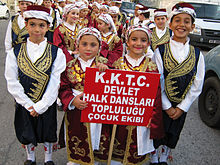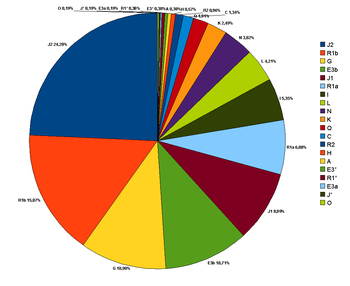土耳其人
| 土耳其人 Türkler | |
|---|---|
| 總人口 | |
| 大約7200–7700 萬 | |
| 分佈地區 | |
(2008 est. of 2015 pop.)[1] | |
| 2,774,000 (包括土耳其庫德人)[4] | |
| 820,000 (2014 estimate)[5][5] | |
| 500,000[a][6][7][8] | |
| 396,414[e]–500,000[c][9][10][11][12] | |
| 350,000–500,000[13][14] | |
| 200,000[15][16][17] | |
| 196,222–500,000 [b][18][19][20][21] | |
| 100,000–150,000[22][23] | |
| 70,440 [e][24] | |
| 66,919–150,000 [b][25][26][27][28] | |
| 28,892 [f][b][29] | |
| 24,910 [b][30] | |
| 22,580 [e][31] | |
| 22,000[32] | |
| 500,000–3,000,000[33][34][35][l] | |
| 100,000[36] | |
| 150,000–200,000 [b][37][38] | |
| 60,000[37] | |
| 50,000–200,000[39][40][41][42] | |
| 50,000 [b][37] | |
| 588,318–800,000[43][44][45] | |
| 77,959[46][47][48][49] | |
| 49,000 (官方統計)–130,000 [g][50][51][52][53] | |
| 27,700[54][55][56] | |
| 18,738[57] | |
| 109,883–150,000[58][59] | |
| 104,792–150,000 [h][60][61] | |
| 40,953–50,000 [h][62][61][63] | |
| 38,000–110,000 [h][64][61][65][66] | |
| 語言 | |
| 土耳其語 | |
| 宗教信仰 | |
| 主要為 (遜尼派、阿列維派、拜克塔什教團、十二伊瑪目派) 少數無宗教[67][71]、基督宗教[72][73]、猶太教[74] | |
| 相关族群 | |
| 突厥語民族(特別是阿塞拜疆人與土庫曼人) 希臘人、亞美尼亞人、喬治亞人、伊朗人、斯拉夫人 | |
| 註釋 | |
| a. ^ The total figure is merely an estimation; sum of all the referenced populations. | |

土耳其人 (土耳其語:Türkler)是土耳其共和國的主體民族(佔该国人口70-75%),絕大多数信奉伊斯蘭教遜尼派,源自奥斯曼帝國時期。該民族主要分佈於土耳其、北馬其頓、科索沃、波斯尼亞、德國、法國、阿塞拜疆、北塞浦路斯、希臘、俄羅斯、保加利亞、喬治亞、羅馬尼亞、奧地利、英國、荷蘭、比利時、列支敦士登、伊拉克、黎巴嫩、哈薩克斯坦、烏茲別克斯坦、澳大利亞、北美地區等地。 土耳其人祖先最早可追溯至突厥人,使用的語言為土耳其語,屬突厥語系,但因長期與西亞、東歐民族混血導致血緣偏向高加索人種民族,原始突厥血統保留極少。
詞源和民族認同
[编辑]土耳其人主要種族來源是安納托利亞的希臘人、亞美尼亞人、庫爾德人、阿拉伯人與波斯人,以及古代的西臺人、吕底亞人與後來的高加索地區和巴爾幹半島的居民、以及從11世纪以后由中亞遷入小亞細亞的烏古斯人混血而成,血統上偏向高加索人種中的巴爾幹-高加索人種;但在文化心理認同上,土耳其人普遍接受自己是突厥人[75]。
1071年之後,烏古斯人開始在安納托利亞建國,蒙古伊爾汗國時代大量烏古斯人因躲避蒙古人進入安納托利亞,逐渐融入當地居民中,同時將伊斯蘭教信仰帶入土耳其。
在鄂圖曼帝國時代,土耳其人是指安納托利亞東部穆斯林農民,統治階層自稱鄂圖曼人,直到19世紀歐洲民族主義傳播至鄂圖曼帝國,他們才開始自稱土耳其人(之前土耳其人只是穆斯林米利特一部分,在當時土耳其人有“農民,粗魯,無所事事的意思”)。
文化
[编辑]藝術與建築
[编辑]
土耳其建築在鄂圖曼帝國時期發展達到巔峰;受塞爾柱,拜占庭和伊斯蘭建築影響的鄂圖曼建築開始發展自己的風格[76],鄂圖曼建築混合地中海和中東建築的風格。隨著土耳其從封建帝國轉變成民主共和國,實行政教的分離政策,藝術表現方式的大量增加。土耳其政府投入大量資源進入藝術領域;如博物館,劇院,歌劇院和建築。[77]
傳統的土耳其音樂包括源自鄂圖曼王朝宮廷的土耳其民間音樂(Halk Müziği),土耳其民間音樂,Fasıl和奧斯曼古典音樂。[78]
現代土耳其音樂包含土耳其流行音樂,搖滾和土耳其嘻哈音樂。[78]
語言
[编辑]土耳其語,也稱土耳其文,屬於突厥語系烏古斯語支。在土耳其、巴爾幹半島、賽普勒斯、梅斯赫蒂和以前鄂圖曼帝國統治的區域。土耳其語是土耳其共和國的官方語言。在巴爾幹半島,土耳其裔仍然使用土耳其語,特別是在保加利亞,希臘(主要是西色雷斯),科索沃,馬其頓共和國,羅馬尼亞(主要在多布羅加)和摩爾多瓦(主要在加告茲)。[79] 塞浦路斯的土耳其語於1571年被鄂圖曼帝國征服時被引入,並成為很重要的語言。[80]
宗教
[编辑]根據中央情報局的統計資料,土耳其99.8%的人口是穆斯林,大多數是遜尼派(哈乃斐派),其餘的0.2%主要是基督徒和猶太人。[82]土耳其估計有1千萬到1千5百萬的阿列維派穆斯林。[83] 土耳其的基督徒族群包括敘利亞人[84],亞美尼亞人和希臘人[85]。土耳其猶太人主要是塞法迪猶太人[86];土耳其基督教新教信徒主要為穆斯林改宗者。[87][88][89][90]
根據KONDA研究,只有9.7%的人口稱自己是“完全虔誠的信徒”,而52.8%的人表示自己有“宗教信仰”。[91] 69.4%的受訪者表示他們或他們的太太會穿著伊斯蘭蓋頭(其中1.3%是卡多爾),儘管這一比率在幾個人口統計學中下降:18-28 歲時有53%,大學畢業有27.5%,碩士或更高學位有16.1% 。[67]自共和國時代以來,土耳其為一個世俗國家。[92]根據一項民意調查,90%的受訪者表示,土耳其應被定義為世俗國家。[93]
基因遺傳來源
[编辑]早期研究土耳其人基因,大都認為土耳其人基因為中亞突厥人的基因,2003年一項關於等位基因頻率的研究表明,屬於蒙古人種的突厥人與現代小亞細亞土耳其人之間缺乏遺傳關係,儘管土耳其人使用的土耳其語屬於突厥語系。[94]根據American Journal of Physical Anthropology(2008)研究,今天的土耳其人與巴爾幹半島的種族的關係比與中亞的種族更為接近[95],然而,最近的研究提到了混血基因。
根據2021年的Turkish DNA Project(土耳其人的DNA檢測專案),土耳其人有53.5%為安納托利亞土著血統,也就是古希臘人血統。15.75%才是突厥人血統,還有13.8%為巴爾幹人血統,另外7%為亞美尼亞人血統;6.4%為伊朗人血統;3.6%為喬治亞人血統。
土耳其人的人類Y染色體DNA單倍型類群分佈
[编辑]
- Haplogroup J2 (Y-DNA)=24.28% – J2 (M172) 最有可能的起源地為高加索、黎凡特和美索不達米亞一帶,今主要在西亞、中亞、南亞和東南歐和北非的男性人口身上找到
- Haplogroup R1b (Y-DNA)=15.87% - 最有可能的起源地為西亞或中亞,今主要在西歐的凱爾特人(愛爾蘭人、西班牙人等)、東歐的巴什基爾人、中非的乍得和喀麥隆的男性人口身上找到,凱爾特人曾在西元前3世紀入侵安納托利亞半島(參見:加拉太人)
- Haplogroup G (Y-DNA)=10.9% – 最有可能的起源地為西亞,今主要在格魯吉亞男性人口身上找到
- Haplogroup E1b1b (Y-DNA)=10.7% 最有可能起源地為東北非或非洲之角,今主要在北非和非洲之角的男性人口身上找到[97]
- Haplogroup J1 (Y-DNA)=8.99% – 最有可能的起源地為西亞,今主要在阿拉伯半島和蘇丹的男性人口身上找到
- Haplogroup R1a (Y-DNA)=6.88% – 最有可能的起源地為歐亞,今主要在中亞、南亞、中歐、東歐和東南歐的男性人口身上找到
- Haplogroup I (Y-DNA)=5.35% – 最有可能的起源地為中歐,今主要在北歐、東歐、東南歐、西亞的男性人口身上找到
- Haplogroup L (Y-DNA)=4.21% – 最有可能的起源地為西亞、南亞或帕米爾高原,今主要印度次大陸和呼羅珊(現在西亞和中亞部分地區)的男性人口身上找到,在高加索地區也有零星分佈
- Haplogroup N (Y-DNA)=3.82% – 最有可能的起源地為東亞,今主要在歐亞大陸北部的男性人口身上找到
- Haplogroup K (Y-DNA)=2.49% – 最有可能的起源地為亞洲,幾乎在所有大陸上的男性人口當中都有一定比率屬於此單倍群
- Haplogroup Q (Y-DNA)=1.91% – 最有可能的起源地為中亞或西伯利亞中南部,為典型的古西伯利亞單倍群,今主要在西伯利亞、土庫曼、羅馬尼亞的塞凱伊人和南北美洲原住民的男性人口身上找到
- Haplogroup C (Y-DNA)=1.34% – 最有可能的起源地為西南亞、東南亞或中亞,今主要在中亞、東亞男性人口,以及澳洲、北美洲的原住民男性人口身上找到
- Haplogroup R2 (Y-DNA)=0.96% – 最有可能的起源地為南亞或中亞,今主要在南亞或中亞男性人口身上找到
- Haplogroup H (Y-DNA)=0.57% – 最有可能的起源地為南亞或西南亞,今主要在南亞的男性人口,以及羅姆人、高棉人的男性人口身上找到
- Haplogroup A (Y-DNA)=0.38% – 最有可能的起源地為非洲,為最原始的Y染色體單倍群,今主要在南非和中非的男性人口身上找到
- Haplogroup E3* (Y-DNA)=0.38% – 最有可能的起源地為東非,今零星分佈在中東和歐洲的男性人口身上
- Haplogroup R1 (Y-DNA)=0.38% – 最有可能的起源地為中亞、南亞或西南亞,在歐亞大陸和美洲都有分佈
- Haplogroup E3A (Y-DNA)=0.19 – 最有可能的起源地為西非或中非,因班圖人擴張而廣泛分佈在非洲同操尼日爾-剛果語系各語言的男性人口中
- Haplogroup J* (Y-DNA)=0.19 - 最有可能的起源地為西亞,今主要在北非、中東、東南歐的男性人口身上找到
- Haplogroup O (Y-DNA)=0.19 - 最有可能的起源地為東亞,今主要在東亞、東南亞、波利尼西亞的男性人口身上找到
参考文献
[编辑]- ^ CIA. The World Factbook. [2011-07-27]. (原始内容存档于2017-09-20).
- ^ CIA. The World Factbook. [2015-06-13]. (原始内容存档于2018-12-26).
- ^ KKTC 2011 NUFUS VE KONUT SAYIMI (PDF). [2014-02-14]. (原始内容存档 (PDF)于2013-09-27).
- ^ Bevölkerung mit Migrationshintergrund - Ergebnisse des Mikrozensus - Fachserie 1 Reihe 2.2 - 2017 (PDF). Statistisches Bundesamt: 61. [2019-07-17]. (原始内容存档 (PDF)于2019-07-17) (德语).
- ^ 5.0 5.1 Présentation de la Turquie. France Diplomatie : : Ministère de l'Europe et des Affaires étrangères. [2017-12-12]. (原始内容存档于2021-01-16).
- ^ Home Affairs Committee 2011,38
- ^ UK immigration analysis needed on Turkish legal migration, say MPs. The Guardian. 2011-08-01 [2011-08-01]. (原始内容存档于2011-08-02).
- ^ Federation of Turkish Associations UK. Short history of the Federation of Turkish Associations in UK. 2008-06-19 [2011-04-13]. (原始内容存档于2012-01-10).
- ^ CBS Statline. opendata.cbs.nl. [2019-08-10]. (原始内容存档于2017-08-03).
- ^ Netherlands Info Services. Dutch Queen Tells Turkey 'First Steps Taken' On EU Membership Road. [2008-12-16]. (原始内容存档于2009-01-13).
- ^ Dutch News. Dutch Turks swindled, AFM to investigate. [2008-12-16]. (原始内容存档于2018-12-25).
- ^ Türkiye Büyük Millet Meclisi 2008,11.
- ^ Turkey's ambassador to Austria prompts immigration spat. BBC News. 2010-11-10 [2010-11-10]. (原始内容存档于2017-09-19).
- ^ CBN. Turkey's Islamic Ambitions Grip Austria. [2011-10-16]. (原始内容存档于2010-04-09).
- ^ Population par nationalité, sexe, groupe et classe d'âges au 1er janvier 2010 - - Home. [2019-08-10]. (原始内容存档于2011-12-22).
- ^ King Baudouin Foundation 2008,5.
- ^ De Morgen. Koning Boudewijnstichting doorprikt clichés rond Belgische Turken. [2010-11-15]. (原始内容存档于2012-07-29).
- ^ U.S. Census Bureau. TOTAL ANCESTRY REPORTED Universe: Total ancestry categories tallied for people with one or more ancestry categories reported 2013 American Community Survey 1-Year Estimates. [2012-10-03]. (原始内容存档于2013-06-02).
- ^ Encyclopedia of Cleveland History. Immigration and Ethnicity: Turks. [2010-02-07]. (原始内容存档于2018-12-25).
- ^ The Washington Diplomat. Census Takes Aim to Tally'Hard to Count' Populations. [2011-05-05]. (原始内容存档于2018-12-25).
- ^ Farkas 2003,40.
- ^ Swedish International Development Cooperation Agency. Turkiet är en viktig bro mellan Öst och Väst. [2011-04-14]. (原始内容存档于2012-09-11).
- ^ Swedish Ministry for Foreign Affairs. Ankara Historia. [2011-04-14]. (原始内容存档于2011-07-22).
- ^ Ständige ausländische Wohnbevölkerung nach Staatsangehörigkeit, am Ende des Jahres (页面存档备份,存于互联网档案馆) Swiss Federal Statistical Office, accessed 6 October 2014
- ^ Australian Government Department of Immigration and Border Protection (PDF). [2015-06-13]. (原始内容 (PDF)存档于2014-07-14).
- ^ Old foes, new friends. The Sydney Morning Herald. 2005-04-23 [2008-12-26]. (原始内容存档于2017-12-16).
- ^ Presidency of the Republic of Turkey. Turkey-Australia: "From Çanakkale to a Great Friendship. 2010 [2011-07-14]. (原始内容存档于2011-10-04).
- ^ OECD. International Questionnaire: Migrant Education Policies in Response to Longstanding Diversity: TURKEY (PDF). Organisation for Economic Co-operation and Development: 3. 2009 [2019-08-10]. (原始内容存档 (PDF)于2011-06-01).
- ^ Statistikbanken. Danmarks Statistik. [2015-06-13]. (原始内容存档于2012-07-14).
- ^ Population by selected ethnic origins, by province and territory (2006 Census). statcan.gc.ca. 2009-07-28 [2010-09-10]. (原始内容存档于2011-01-15).
- ^ I cittadini non comunitari regolarmente soggiornanti Ascolta. [2016-05-01]. (原始内容存档于2014-11-13).
- ^ Council of Europe 2007,131.
- ^ Park 2005,37.
- ^ Phillips 2006,112.
- ^ Bassem, Wassim. Iraq’s Turkmens call for independent province. Al-Monitor. 2016 [2019-08-10]. (原始内容存档于2016-10-17).
Turkmens are a mix of Sunnis and Shiites and are the third-largest ethnicity in Iraq after Arabs and Kurds, numbering about 3 million out of the total population of about 34.7 million, according to 2013 data from the Iraqi Ministry of Planning.
- ^ Phillips, David J. Peoples on the Move: Introducing the Nomads of the World. William Carey Library. 2001-01-01: 301 [2012-11-12]. ISBN 978-0-87808-352-7. (原始内容存档于2021-01-16).
- ^ 37.0 37.1 37.2 Akar 1993,95.
- ^ Karpat 2004,12.
- ^ Al-Akhbar. Lebanese Turks Seek Political and Social Recognition. [2012-03-02]. (原始内容存档于2018-06-20).
- ^ Tension adds to existing wounds in Lebanon. Today's Zaman. [2011-04-06]. (原始内容存档于2012-01-11).
- ^ Ahmed, Yusra, Syrian Turkmen refugees face double suffering in Lebanon, Zaman Al Wasl, 2015 [2016-10-11], (原始内容存档于2017-08-23)
- ^ Syrian Observer. Syria's Turkmen Refugees Face Cruel Reality in Lebanon. 2015 [2016-10-10]. (原始内容存档于2016-10-11).
- ^ National Statistical Institute of Bulgaria. 2011 Population Census in the Republic of Bulgaria (Final data) (PDF). National Statistical Institute of Bulgaria. 2011 [2019-08-10]. (原始内容存档 (PDF)于2013-04-03).
- ^ Sosyal 2011,369.
- ^ Bokova 2010,170.
- ^ Census of Population, Households and Dwellings in the Republic of Macedonia, 2002 (PDF). Stat.gov.mk. [2017-12-12]. (原始内容存档 (PDF)于2010-09-22).
- ^ Republic of Macedonia State Statistical Office 2005,34.
- ^ Knowlton 2005,66.
- ^ Abrahams 1996,53.
- ^ GREEK HELSINKI MONITOR. Minelres.lv. [2017-12-12]. (原始内容存档于2003-05-23).
- ^ Demographics of Greece. European Union National Languages. [2010-12-19]. (原始内容存档于2021-01-15).
- ^ Destroying Ethnic Identity: The Turks of Greece (PDF). Human Rights Watch. [2018-01-03]. (原始内容存档 (PDF)于2021-01-16).
- ^ Turks Of Western Thrace. Human Rights Watch. [2018-01-03]. (原始内容存档于2021-01-18).
- ^ (罗马尼亚文) "Comunicat de presă privind rezultatele definitive ale Recensământului Populaţiei şi Locuinţelor – 2011" (页面存档备份,存于互联网档案馆), at the 2011 Romanian census site; accessed 11 July 2013
- ^ Phinnemore 2006,157.
- ^ Constantin, Goschin & Dragusin 2008,59.
- ^ 2011 census in the Republic of Kosovo
- ^ 2010 Russia census
- ^ Ryazantsev 2009,172.
- ^ Агентство Республики Казахстан по статистике. Этнодемографический сборник Республики Казахстан 2014.. Stat.gov.kz. [2017-12-12]. (原始内容存档于2017-11-08).
- ^ 61.0 61.1 61.2 Aydıngün et al. 2006,13.
- ^ Kyrgyz 2009 census
- ^ IRIN Asia. KYRGYZSTAN: Focus on Mesketian Turks. [2010-03-17]. (原始内容存档于2018-12-25).
- ^ Wayback Machine. Web.archive.org. 2012-11-30 [2017-12-12]. (原始内容存档于2012-11-30).
- ^ UNHCR 1999,14.
- ^ NATO Parliamentary Assembly. Minorities in the South Caucasus: Factor of Instability?. [2012-01-16]. (原始内容存档于2012-03-08).
- ^ 67.0 67.1 67.2 Religion, Secularism and the Veil in Daily Life Survey (PDF). Konda Arastirma. September 2007 [2013-05-24]. (原始内容存档于2009-03-25).
- ^ IHGD - Soru Cevap - Azınlıklar. Sorular.rightsagenda.org. [2015-03-18]. (原始内容存档于2018-11-30).
- ^ THE ALEVI OF ANATOLIA: TURKEY'S LARGEST MINORITY. Angelfire.com. [2015-03-18]. (原始内容存档于2012-04-23).
- ^ Shi'a. Web.archive.org. [2015-03-18]. (原始内容存档于2021-01-16).
- ^ ReportDGResearchSocialValuesEN2.PDF (PDF). Ec.europa.eu. [2017-12-12]. (原始内容存档 (PDF)于2011-08-21).
- ^ name="hurriyetdailynews.com">TURKEY - Christians in eastern Turkey worried despite church opening. Hurriyetdailynews.com. [2015-03-18]. (原始内容存档于2017-06-20).
- ^ BBC News - When Muslims become Christians. News.bbc.co.uk. [2015-03-18]. (原始内容存档于2017-06-20).
- ^ The World Factbook — Central Intelligence Agency. Cia.gov. [2017-12-12]. (原始内容存档于2017-09-20).
- ^ Excavating Y-chromosome haplotype strata in Anatolia. Hum Genet (2004) 114 : 127–148, Springer-Verlag 2003 (PDF). [2017-03-12]. (原始内容 (PDF)存档于2006-06-19).
- ^ Necipoğlu, Gülru. Muqarnas: An Annual on Islamic Art and Architecture. Volume 12. Leiden : E.J. Brill. 1995: 60 [2008-07-07]. ISBN 9789004103146. OCLC 33228759.
- ^ Grabar, Oleg. Muqarnas: An Annual on Islamic Art and Architecture. Volume 3. Leiden : E.J. Brill. 1985 [2008-07-07]. ISBN 978-9004076112.
- ^ 78.0 78.1 Martin Dunford; Terry Richardson. The Rough Guide to Turkey. Rough Guides. 2013-06-03: 647– [2013-07-25]. ISBN 978-1-4093-4005-8. (原始内容存档于2021-01-16).
- ^ Johanson 2011,734–738.
- ^ Johanson 2011,738.
- ^ Turkey. Joshua Project. [2015-04-04]. (原始内容存档于2020-04-22).
- ^ CIA World Factbook. CIA. March 2011 [2011-03-03]. (原始内容存档于2017-09-20).
- ^ Shankland, David. The Alevis in Turkey: The Emergence of a Secular Islamic Tradition. Routledge (UK). 2003. ISBN 978-0-7007-1606-7.
- ^ Pieter H. Omtzigt; Markus K. Tozman; Andrea Tyndall. The Slow Disappearance of the Syriacs from Turkey: And of the Grounds of the Mor Gabriel Monastery. LIT Verlag Münster. 2012 [2019-08-12]. ISBN 978-3-643-90268-9. (原始内容存档于2021-01-18).
- ^ Religious Freedom Report (页面存档备份,存于互联网档案馆) U.S. Department of State. Retrieved 15 September 2009.
- ^ Judith R. Baskin; Kenneth Seeskin. The Cambridge Guide to Jewish History, Religion, and Culture. Cambridge University Press. 2010: 145– [2019-08-12]. ISBN 978-0-521-86960-7. (原始内容存档于2021-01-16).
- ^ TURKEY - Christians in eastern Turkey worried despite church opening. Hurriyetdailynews.com. [2015-03-18]. (原始内容存档于2017-06-20).
- ^ Turkish Protestants still face "long path" to religious freedom - The Christian Century. The Christian Century. [2015-03-18]. (原始内容存档于2014-10-17).
- ^ Muslim Nationalism and the New Turks. Books.google.com. [2015-03-18]. (原始内容存档于2020-06-15).
- ^ TURKEY: Protestant church closed down - Church In Chains - Ireland 🆚 An Irish voice for suffering, persecuted Christians Worldwide. Churchinchains.ie. [2015-03-18]. (原始内容存档于2016-08-22).
- ^ KONDA. Religion, Secularism and the Veil in Daily Life Survey (PDF). Konda Arastirma. 2007 [2013-05-24]. (原始内容 (PDF)存档于2009-03-25).
- ^ Ahmet T. Kuru; Alfred C. Stepan. Democracy, Islam, and secularism in Turkey. Columbia University Press. 2012 [2019-08-12]. ISBN 978-0-231-53025-5. (原始内容存档于2021-01-16).
- ^ More secular, green Turkey wanted: Poll. Hürriyet Daily News. 2012-11-23 [2013-05-22]. (原始内容存档于2017-06-20).
- ^ Machulla, H. K. G.; Batnasan, D.; Steinborn, F.; Uyar, F. A.; Saruhan-Direskeneli, G.; Oguz, F. S.; Carin, M. N.; Dorak, M. T. Genetic affinities among Mongol ethnic groups and their relationship to Turks. Tissue Antigens. 2003, 61 (4): 292–299. PMID 12753667. doi:10.1034/j.1399-0039.2003.00043.x.
- ^ Berkman, C. C.; Dinc, H.; Sekeryapan, C.; Togan, I. Alu insertion polymorphisms and an assessment of the genetic contribution of Central Asia to Anatolia with respect to the Balkans. American Journal of Physical Anthropology. 2008, 136 (1): 11–18. PMID 18161848. doi:10.1002/ajpa.20772.
- ^ 引用错误:没有为名为
stanford的参考文献提供内容 - ^ Cruciani, F.; La Fratta, R.; Torroni, A.; Underhill, P. A.; Scozzari, R. Molecular dissection of the Y chromosome haplogroup E-M78 (E3b1a): A posteriori evaluation of a microsatellite-network-based approach through six new biallelic markers. Human Mutation. 2006, 27 (8): 831–2. PMID 16835895. doi:10.1002/humu.9445.
| |||||||
| ||||||||||||||||||||||||||||||||||||||||||||||||||||||||||||||||||
| ||||||||||||
Text is available under the CC BY-SA 4.0 license; additional terms may apply.
Images, videos and audio are available under their respective licenses.

